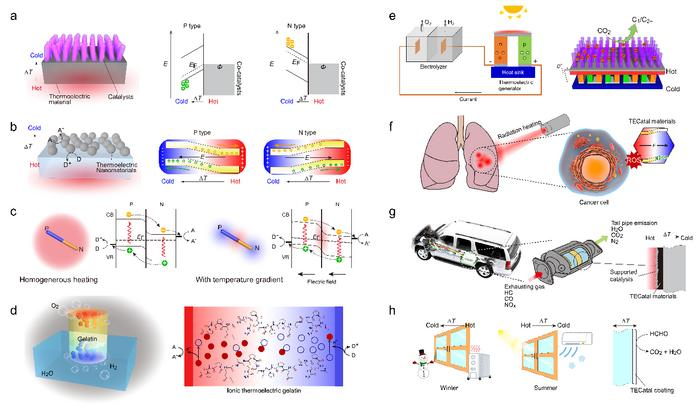Energy consumption has grown immensely, though less than 40% of primary energy is being used efficiently; the remaining portion is discarded as waste heat, which causes significant energy waste and exacerbates environmental problems.
 Working modes of TECatal systems: (a) hybrid structure mode, (b) single-phase mode, (c) P-N nanojunction mode, and (d) thermogalvanic cell mode. Potential applications of TECatal materials in (e) H2 production and CO2 reduction, (f) tumor therapy, (g) vehicle tail gas treatment, and (h) window glass coating for indoor air purification. Image Credit: Science China Press
Working modes of TECatal systems: (a) hybrid structure mode, (b) single-phase mode, (c) P-N nanojunction mode, and (d) thermogalvanic cell mode. Potential applications of TECatal materials in (e) H2 production and CO2 reduction, (f) tumor therapy, (g) vehicle tail gas treatment, and (h) window glass coating for indoor air purification. Image Credit: Science China Press
Thermoelectric materials, a novel energy material capable of directly converting thermal energy to electrical energy, are gaining popularity in the field of waste heat recovery. When a temperature differential exists between the two ends of thermoelectric materials, a thermoelectromotive force is formed within the material, resulting in the conversion of thermal energy to electrical energy.
Recently, thermoelectric materials have opened up new possibilities for catalysis in addition to being used as electric generators. Sufficient driving force for catalytic processes is provided by the small temperature gradient (<100 °C) created by the widespread heat in nature and industrial output.
This makes it possible to drive numerous catalytic processes, including the synthesis of organic compounds, the creation of hydrogen, environmental purification, and biomedical applications, using low-grade waste heat resources again. It provides a fresh approach to enhancing green catalysis, energy conservation, pollution reduction, and energy usage efficiency.
The team from Jiangsu University’s Institute of Quantum and Sustainable Technology has proposed the conceptual application direction of thermoelectrocatalysis (TECatal) based on the latest developments in this emerging field.
They have also compiled a systematic summary of the materials and modes of operation currently available for thermoelectric catalysis. Thermogalvanic cell mode, P-N nanojunction mode, hybrid structure mode, and single-phase mode were proposed as the four major operating modes.
The study looks at approaches to optimize band engineering, stability, microstructures, and thermoelectric characteristics to enhance the performance of thermoelectric catalytic materials. Additionally, the potential applications of thermoelectric catalytic materials in fields including environmental governance, tumor treatment, and green energy were suggested and explored, offering crucial references for the field’s future advancement.
Journal Reference:
Zhang, Y., et. al. (2024) Thermoelectrocatalysis: an emerging strategy for converting waste heat into chemical energy. National Science Review. doi:10.1093/nsr/nwae036.